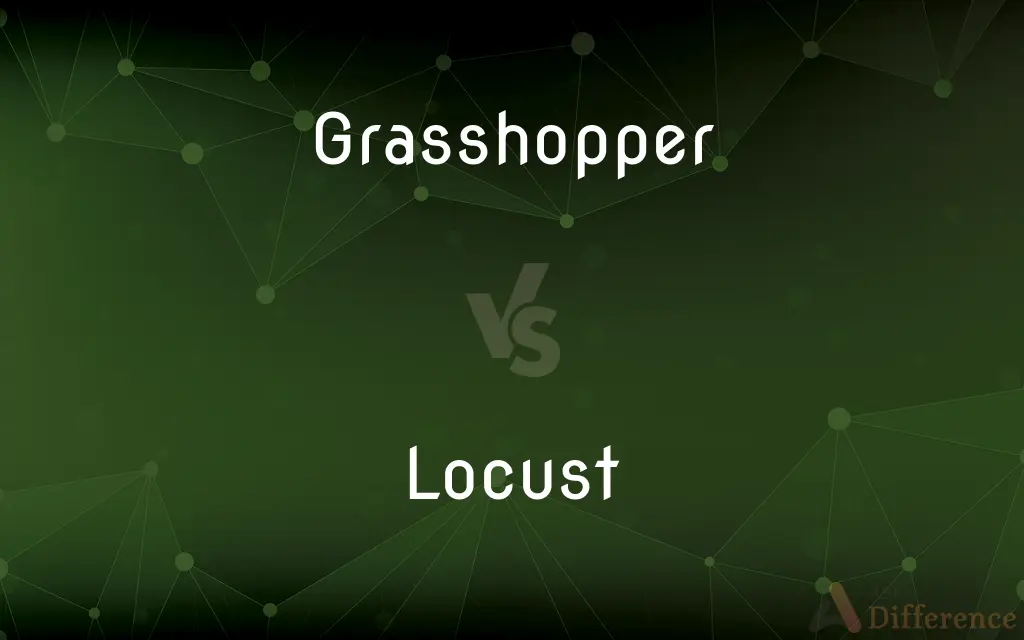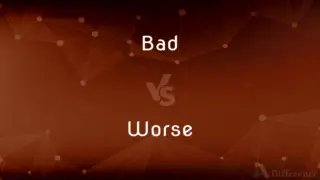Grasshopper vs. Locust — What's the Difference?
By Tayyaba Rehman — Updated on October 12, 2023
Grasshoppers are insects with powerful hind legs for jumping, while locusts are grasshoppers that can swarm and cause significant agricultural damage.

Difference Between Grasshopper and Locust
Table of Contents
ADVERTISEMENT
Key Differences
Grasshoppers are insects belonging to the suborder Caelifera and are known for their strong hind legs that enable them to jump long distances. Locusts, on the other hand, are a specific type of grasshopper that has the ability to change behavior and form swarms under suitable conditions.
While both grasshoppers and locusts belong to the same suborder, not all grasshoppers become locusts. Locusts are distinguished by their unique swarming phase, which can result in massive groups that devastate vegetation.
The behavior of grasshoppers is typically solitary, and they do not form the large, migrating groups associated with locusts. Locusts, in contrast, can transition from a solitary phase to a gregarious phase, wherein they form large swarms and migrate over vast distances.
Grasshoppers are found globally, across various habitats, and are a common sight in fields and gardens. Locusts, due to their swarming nature, are often considered pests, especially in regions where their swarms can lead to significant agricultural loss.
Both grasshoppers and locusts have a similar diet, primarily feeding on plants. However, the sheer number of locusts in a swarm can lead to rapid defoliation, making their impact on vegetation much more devastating than that of solitary grasshoppers.
ADVERTISEMENT
Comparison Chart
Classification
Insect from the suborder Caelifera
Type of grasshopper that can change behavior and swarm
Behavior
Typically solitary
Can be solitary or gregarious (swarming)
Impact on Vegetation
Minimal due to solitary nature
Significant due to swarming nature
Global Distribution
Found worldwide
Found in specific regions, especially where swarms occur
Associated Issues
General plant consumption
Major agricultural pests due to swarming
Compare with Definitions
Grasshopper
An insect from the suborder Caelifera.
Grasshoppers can be found in many gardens and fields.
Locust
A type of grasshopper that can form large swarms.
The village prepared for the impending locust invasion.
Grasshopper
A long-bodied insect with strong hind legs for jumping.
The grasshopper landed on a nearby leaf.
Locust
Often associated with biblical plagues due to their destructive nature.
Historical records often describe locust invasions as catastrophic events.
Grasshopper
Known for its song produced by rubbing its wings together.
You can often hear the song of the grasshopper in the summer.
Locust
Can transition from a solitary to a gregarious phase.
The locust's behavior changes drastically when in its gregarious phase.
Grasshopper
Recognized by its long antennae and powerful jumping legs.
The grasshopper's ability to jump is truly remarkable.
Locust
Has a swarming behavior under certain conditions.
Locust swarms are often triggered by specific environmental cues.
Grasshopper
A herbivorous insect that feeds on plants.
The grasshopper was munching on some fresh greens.
Locust
Locusts (derived from the Vulgar Latin locusta, meaning grasshopper) are a group of certain species of short-horned grasshoppers in the family Acrididae that have a swarming phase. These insects are usually solitary, but under certain circumstances they become more abundant and change their behaviour and habits, becoming gregarious.
Grasshopper
Grasshoppers are a group of insects belonging to the suborder Caelifera. They are among what is probably the most ancient living group of chewing herbivorous insects, dating back to the early Triassic around 250 million years ago.
Locust
Any of various short-horned grasshoppers that sometimes migrate in immense swarms, devouring vegetation and crops.
Grasshopper
Any of numerous orthopteran insects, chiefly of the suborder Caelifera, characteristically having long, powerful hind legs adapted for jumping.
Locust
A cicada, especially a periodical cicada.
Grasshopper
A light, usually unarmed airplane used for liaison and scouting.
Locust
Any of several trees of the pea family bearing long pods, especially the black locust, honey locust, and carob.
Grasshopper
A cocktail consisting of crème de menthe, crème de cacao, and cream.
Locust
The wood of any of these trees.
Grasshopper
A mostly herbivorous insect of the order Orthoptera, noted for its ability to jump long distances and for the habit of some species communicating by stridulation; they are related to but distinct from crickets.
Locust
Any of the grasshoppers, often polyphenic and usually swarming, in the family Acrididae that are very destructive to crops and other vegetation, especially the migratory locust (Locusta migratoria).
Grasshopper
In the strict sense, refers to insects in the suborder Caelifera, particularly those in the family Acrididae.
Locust
A fruit or pod of the carob tree.
Grasshopper
In a looser sense, also includes the katydids (also known as longhorned grasshoppers or bush crickets), which are members of the family Tettigoniidae, of the suborder Ensifera.
Locust
Any of various often leguminous trees and shrubs, especially of the genera Robinia and Gleditsia; the locust tree.
Grasshopper
A cocktail made with crème de menthe and optionally with crème de cacao.
Locust
A cicada.
Grasshopper
(figuratively) A young student in initial stages of training who has been chosen on account of their obvious talent.
Locust
A Mainlander.
Grasshopper
(musical instrument) In ordinary square or upright pianos of London make, the escapement lever or jack, so made that it can be taken out and replaced with the key.
Locust
(intransitive) To come in a swarm.
Grasshopper
Any jumping, orthopterous insect, of the families Acrididæ and Locustidæ, having large hind legs adapted for leaping, and chewing mouth parts. The species and genera are very numerous and some are very destructive to crops. The former family includes the Western grasshopper or locust (Caloptenus spretus), noted for the great extent of its ravages in the region beyond the Mississippi. In the Eastern United States the red-legged (Caloptenus femurrubrum and C. atlanis) are closely related species, but their ravages are less important. They are closely related to the migratory locusts of the Old World. See Locust.
Locust
Any one of numerous species of long-winged, migratory, orthopterous insects, of the family Acrididæ, allied to the grasshoppers; esp., (Edipoda migratoria, syn. Pachytylus migratoria, and Acridium perigrinum, of Southern Europe, Asia, and Africa. In the United States the related species with similar habits are usually called grasshoppers. See Grasshopper.
Grasshopper
In ordinary square or upright pianos of London make, the escapement lever or jack, so made that it can be taken out and replaced with the key; - called also the hopper.
Locust
The locust tree. See Locust Tree (definition, note, and phrases).
Grasshopper
An antipersonnel mine that jumps from the ground to body height when activated, and explodes, hurling metal fragments over a wide area.
Locust
Migratory grasshoppers of warm regions having short antennae
Grasshopper
A mixed alcoholic beverage containing crème de menthe, light cream, and sometimes crème de cacao. The name comes from its light green color.
Locust
Hardwood from any of various locust trees
Grasshopper
Terrestrial plant-eating insect with hind legs adapted for leaping
Locust
Any of various hard-wooded trees of the family Leguminosae
Grasshopper
A cocktail made of creme de menthe and cream (sometimes with creme de cacao)
Locust
Known for causing significant agricultural damage.
The locust swarm devoured the entire crop in hours.
Common Curiosities
Why can locusts be a problem for farmers?
Locusts, when swarming, can rapidly consume vast areas of vegetation, leading to significant agricultural losses.
Are grasshoppers harmful to crops?
While a single grasshopper can consume plants, they typically don't cause the widespread damage associated with locust swarms.
How can locust swarms be controlled?
Locust swarms can be controlled using pesticides, biological controls, and preventive measures.
What causes locusts to swarm?
Locusts swarm due to a combination of environmental factors and population density, leading them to change from solitary to gregarious behavior.
What is the diet of a grasshopper?
Grasshoppers are primarily herbivores, feeding on a variety of plants.
Are there different species of locusts?
Yes, several species of grasshoppers are categorized as locusts due to their swarming behavior.
Are grasshoppers and locusts the same?
No, while all locusts are grasshoppers, not all grasshoppers are locusts. Locusts can form destructive swarms, whereas most grasshoppers don't.
How do grasshoppers produce their distinctive sound?
Grasshoppers produce sound by rubbing their hind legs against their wings, a behavior called stridulation.
How are locust swarms predicted or tracked?
Locust swarms are tracked using satellite imagery, ground surveys, and local reports, helping in early detection and control.
How long can locust swarms last?
A locust swarm's duration varies, but swarms can travel and feed for extended periods, sometimes covering large distances.
10:** Do grasshoppers and locusts have natural predators?
Yes, both are preyed upon by birds, reptiles, rodents, and certain insects.
Why are locust swarms sometimes referred to in biblical or historical texts?
Locust swarms, due to their sudden appearance and vast destruction, are often viewed as plagues or punishments in historical and religious texts.
Can grasshoppers transition into locusts?
Only certain species of grasshoppers can transition into the swarming behavior characteristic of locusts under specific conditions.
How do locusts navigate when they swarm?
Locusts use visual cues, wind patterns, and pheromones to navigate and stay together during swarms.
Is it safe for humans to consume grasshoppers or locusts?
Yes, both grasshoppers and locusts are edible and are consumed as a source of protein in many cultures worldwide.
Share Your Discovery

Previous Comparison
Bad vs. Worse
Next Comparison
Lineman vs. LinesmanAuthor Spotlight
Written by
Tayyaba RehmanTayyaba Rehman is a distinguished writer, currently serving as a primary contributor to askdifference.com. As a researcher in semantics and etymology, Tayyaba's passion for the complexity of languages and their distinctions has found a perfect home on the platform. Tayyaba delves into the intricacies of language, distinguishing between commonly confused words and phrases, thereby providing clarity for readers worldwide.
















































